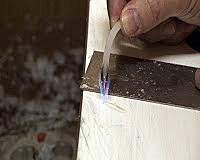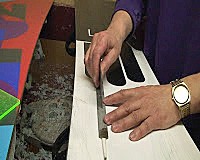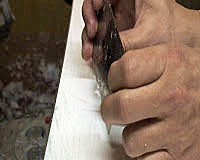by James Streater @maverixsnow
P-tex is the abbreviated name for Polyethylene. There are 10 major classifications of Polyethylene. For snowboards and skis the form used is UHMWPE or Ultra-high-molecular-weight polyethylene. It?s the same material used to make bullet proof jackets as well as hip and knee replacements. The main reason for its choice for skis and snowboards is it?s low moisture absorption, very low coefficient of friction and being resistant to abrasion.
There are two different forms of bases that you may have heard about. They are extruded and sintered. You can find out more about them here. The key thing is that extruded is cheaper and slower yet easier to bond p-tex to (repair). Sintered is expensive, faster, and less easy to bond p-tex to. You often hear about grades of base (1300 extruded, 2000, 4000 sintered). This relates to the molecular weight of the Polyethylene used. The higher the number the more resistant the base is to friction heating, losing wax and becoming slow.
Prepare that hole
Once you have selected what you want to repair you need to clean the gouge out, making sure it has a little bit of depth or the p-tex will not bind to the base. I aim to have the gouge around 1?2 mm deep. I use the corner of a metal scraper to clean out any debris, wax and a little bit of p-tex to make it to the required depth. If you have some sandpaper you can roughen up the surface a little providing a better base for the p-tex to bond to, but make sure you clean it afterwards with base cleaner so there is no dirt in the scratch. I personally think this does not make much diference and invariably ends up with a dirty gouge. Allow at least 20 minutes for the base cleaner to evaporate before you proceed.
Pick your colour
Pick the p-tex colour you want to use. Generally you?ll have white that produces clear filler or black. The thinner the p-tex the easier it will be to heat up and melt.

Burn the P-Tex
If you have loads of money, you could buy a p-tex gun, but you really only need a lighter, your usual metal scraper and some p-tex. The guns are cool, but they can coat the ski or board in tons of p-tex that will need to scraped or ground off. This can take ages. P-tex will hold it?s own flame, once it gets up to temperature. I would place the scraper next to the area you want to repair, and then light the p-tex. Once it starts to melt you can then move the p-tex over to start filling the hole

With the white ptex you can get a lot of carbon (black spots) in it if you raise it too high as it burns. Keep it low enough to maintain a nice blue flame, but not high enough to develop the typical candle flame colour (as shown left). You do not have to worry so much about this with black p-tex as you?ll never see the carbon deposits.
Trace the line taking your time and try to avoid lingering in one spot as that will build up lumps of p-tex on the board. Those lumps will most likely not fully bond to the board and also require additional tools like a flat bastard file to remove the excess. If you go too fast you will get lots of little drops on the base that may not fill in the gouge. To keep things even I place my hand on the board and slide it along rather than holding my hand above the board. That way you can maintain an even height and speed. Once you have melted it into the hole, leave it to cool for approximately 20 minutes.

Scrap away
Following that you can prepare your metal scraper for clearing the excess p-tex. Lay out a file and run your scraper along its length at a slight angle to clean and sharpen the edge.

Once your ready run the scraper at a 35?45 degree angle following the line or very slightly off the line of the scratch with the thumbs of both hands pressing against the back of the scraper creating a slight warp in the blade. That will give you extra pressure to scrap the p-tex flush with the board or ski. If the p-tex becomes a little rough you have started scraping too early. If the p-tex lifts out of the hole you may have melted too much into it, be scraping too much at right-angles to the hole, or the gouge was a little shallow.
If you have not filled in enough of the hole, re-apply more p-tex. Once you have done that the board should be ready for either a gentle sand down over the repair or just straight for a wax. I generally just go for a wax. As with anything like this if you do not really want to risk your gear, then leave it to a professional.
James Streater is the Head Coach and Founder of Maverix Snow Ltd, a snowboard coaching company. James dips into his 16 years of snowsports experience to comment on the snowsports industry and ways to improve your on slope experience. Follow him on twitter @maverixsnow
Originally published at www.maverix.org.

